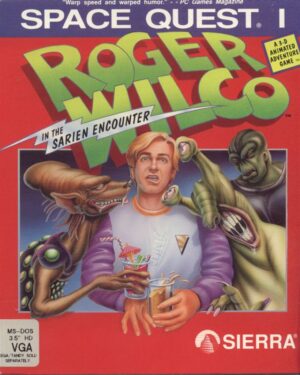Retro Replay Review
Gameplay
Eschalon: Book I embraces a classic, turn-based RPG framework that puts character stats and player decisions at the forefront. Every action—whether it’s drawing a sword, disarming a trap, or casting a fireball—is resolved by a roll influenced by your attributes and trained skills. This adherence to old-school mechanics feels both nostalgic and satisfying for fans of Wizardry and Ultima, where careful planning and tactical foresight can mean the difference between success and a quick respawn.
(HEY YOU!! We hope you enjoy! We try not to run ads. So basically, this is a very expensive hobby running this site. Please consider joining us for updates, forums, and more. Network w/ us to make some cash or friends while retro gaming, and you can win some free retro games for posting. Okay, carry on 👍)
The game’s open-world design invites exploration from the very first moment, though it makes no apologies for its high difficulty curve. You’re free to roam the province of Thaermore, but monsters far stronger than you patrol the more dangerous regions. This design choice rewards patience and strategy: learning enemy patterns, retracing safe paths, and returning later when your character is better equipped and trained in combat or stealth skills.
Character progression in Eschalon: Book I is deep and flexible. You can become an expert swordsman, a nimble thief, a scholarly mage, or a hybrid of all three. Non-combat skills such as cartography and mercantile also play a crucial role—improving your automap clarity or securing better prices from merchants can be just as rewarding as slaying a pack of goblins. This variety ensures each playthrough can feel unique as you experiment with different builds and approaches to overcome obstacles.
Graphics
Visually, Eschalon: Book I opts for an isometric 2D style that pays homage to the golden era of PC RPGs. The hand-drawn environments feature detailed tile sets, from mossy dungeon walls to sunlit forest clearings, each imbued with a rustic, almost painterly charm. While it lacks the high-fidelity textures of modern 3D engines, its stylistic consistency and atmospheric lighting lend the world a timeless quality.
Character and enemy sprites are well-animated within the constraints of 2D art. Motion frames deliver clear feedback—clashing blades, spellcasting gestures, and stealthy backstabs all read crisply on screen. Even the interface elements, such as inventory screens or skill windows, maintain the retro aesthetic without sacrificing usability, striking a balance between authenticity and clarity.
Special effects, like spell animations or explosion bursts, may seem modest by today’s blockbuster standards, but they carry a satisfying punch in context. The developers cleverly use color contrasts and simple particle effects to convey impact, ensuring that combat remains visually engaging. Whether you’re launching a fireball or harvesting resources, the graphical presentation reinforces the game’s old-school roots while remaining accessible to modern audiences.
Story
The narrative of Eschalon: Book I begins with one of the most classic RPG setups: you wake up in an abandoned house in Elderhollow village, stripped of your memories and armed only with a cryptic note. This mystery-driven opening immediately hooks you, as you piece together your identity and purpose while navigating a province torn apart by war. The sense of personal vulnerability amplifies the stakes of every decision, from choosing an ally to confronting hostile forces.
As you explore Thaermore, you uncover a conflict between human settlers and a subterranean race that bears a striking resemblance to dwarves. The game does not spoon-feed lore; instead, it scatters clues through journals, letters, and conversations with NPCs. This approach rewards thorough exploration and keen observation, as each note you discover deepens your understanding of Eschalon’s turbulent political landscape and hints at your own hidden heritage.
The pacing of the story is deliberately measured. There are no grand cinematic cutscenes or voiced dialogues; the plot advances through text-based interactions and environmental storytelling. While this minimalist presentation can feel understated compared to narrative-heavy RPGs, it complements the game’s emphasis on player agency—your choices in dialogue and quest order shape how you experience the unraveling mystery.
Overall Experience
Eschalon: Book I delivers a robust, no-frills RPG experience that will resonate strongly with enthusiasts of classic series like Might & Magic and Ultima. Its combination of open-world exploration, challenging turn-based combat, and flexible character builds offers dozens of hours of engaging gameplay. Patience and strategic thinking are rewarded, making victories feel all the more gratifying.
As an indie title, it wears its modest production values with pride, focusing on substance over spectacle. The soundtrack sets an appropriately moody tone without ever drawing attention away from the core adventuring. Minor rough edges—such as occasional inventory micromanagement or a steeper learning curve—are offset by the sense of discovery and the depth of its skill system.
For players seeking a throwback to the RPGs of the ’80s and ’90s, Eschalon: Book I is a commendable labor of love. Its world feels alive despite its simplicity, and the freedom to chart your own course makes each journey feel personal. If you relish methodical exploration, tactical combat, and unraveling a mystery at your own pace, this title offers a richly rewarding experience that stands proudly alongside its spiritual predecessors.
 Retro Replay Retro Replay gaming reviews, news, emulation, geek stuff and more!
Retro Replay Retro Replay gaming reviews, news, emulation, geek stuff and more!









Reviews
There are no reviews yet.